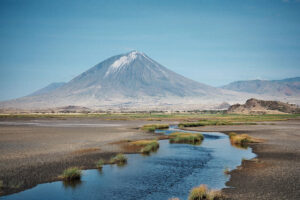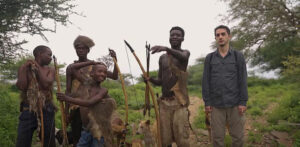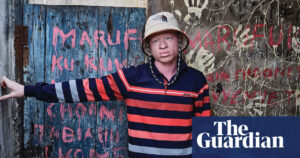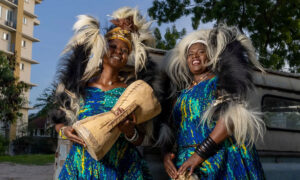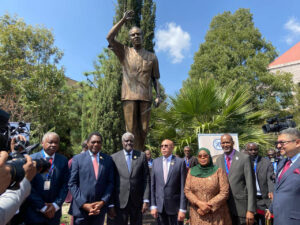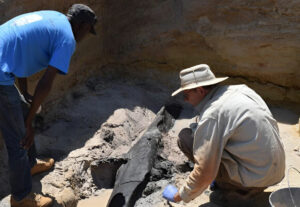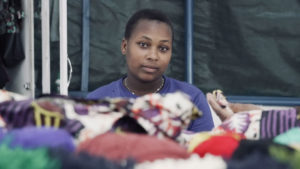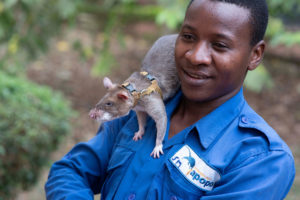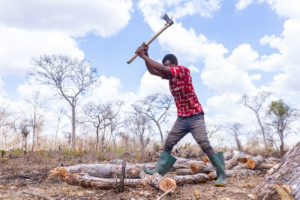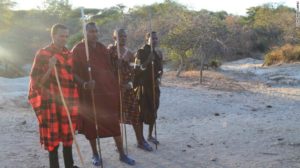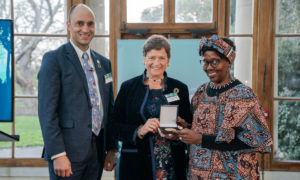by Donovan McGrath
World Bank announces multimillion-dollar redress fund after killings and abuse claims at Tanzanian project
(Guardian online – UK) Extract: The World Bank is embarking on a multimillion-dollar programme in response to alleged human rights abuses against Tanzanian herders during a flagship tourism project it funded for seven years. Allegations made by the pastoralist communities living in and around Ruaha national park include violent evictions, sexual assaults, killings, forced disappearances and large-scale cattle seizures from herders committed by rangers working for the Tanzanian national park authority (Tanapa). The pastoralists say most of the incidents took place after the bank approved $150m (£166m) for the Resilient Natural Resources Management for Tourism and Growth (Regrow) project September in 2017, aimed at developing tourism in four protected areas in southern Tanzania in a bid to take pressure off heavily touristed northern areas such as Ngorongoro and Serengeti. In 2023, two individuals wrote to the bank accusing some Tanapa employees of “extreme cruelty” during cattle seizures and having engaged in “extrajudicial killings” and the “disappearance” of community members… [The] bank published a 70-page report following its own investigation, which found “critical failures in the planning and supervision of this project and that these have resulted in serious harm”. The report … notes that “the project should have recognised that enhancing Tanapa’s capacity to manage the park could potentially increase the likelihood of conflict with communities trying to access the park.” … The report includes recommendations aimed at redressing harms done and details a $2.8m project that will support alternative livelihoods for communities inside and around the park… Anuradha Mittal, executive director of the Oakland Institute, said the “scathing” investigation “confirmed the bank’s grave wrongdoing which devastated the lives of communities. Pastoralists and farms who refused to be silenced amid widespread government repression, are now vindicated.” She added that the bank’s response was “beyond shameful”. “Suggesting that tens of thousands of people forced out of their land can survive with ‘alternative livelihoods’ such as clean cooking and microfinance is a slap in the face of the victims.” … The Oakland Institute said the affected communities reject the bank’s recommendations, and have delivered a list of demands that includes “reverting park boundaries to the 1998 borders … The bank has said any future community resettlement will be the government’s decision. (3 April 2025)
Labour government discussed Tanzania asylum camp plan in 2004, files show
(Guardian online – UK) Extract: Tony Blair’s government discussed diverting £2m earmarked to prevent conflict in Africa in order to fund a controversial pilot scheme to process and house asylum seekers in Tanzania, newly released government files show. Under the scheme, Britain would have offered Tanzania an extra £4m in aid if it opened an asylum camp to house people claiming to be Somalian refugees while their applications to live in Britain were assessed. Hilary Benn, the then international development secretary, wrote to the then home secretary, David Blunkett, in 2004 saying the migration partnership with Tanzania was “off the ground”, files released to the National Archives in Kew, west London, show… The then armed forces minister, Adam Ingram, however, wrote to Benn to say that while he agreed that the removal of refused asylum seekers should be addressed, he did not “consider it appropriate” to draw on the ACPP fund. Ingram wrote: “In the medium and longer terms improving stability in Africa is likely to be one of the more sustainable means of reducing the flow of economic and other migrants; that is what the ACPP exists to achieve… (31 December 2024)
Move over, Med diet – plantains and cassava can be as healthy as tomatoes and olive oil, say researchers
(Guardian online – UK) Extract: Plantains, cassava and fermented banana drink should be added to global healthy eating guidelines alongside the olive oil, tomatoes and red wine of the Mediterranean diet, say researchers who found the traditional diet of people living in Tanzania’s Kilimanjaro region had a positive impact on the body’s immune system. Traditional foods enjoyed in rural villages also had a positive impact on markers of inflammation, the researchers found in a study published . . . in the journal Nature Medicine. Dr Quirijn de Mast, one of the paper’s authors, said they were now in a race against time to record and study the potential benefits of African heritage diets before they disappear as people move to cities and adopt western-style eating habits. “Time is ticking because you see that these heritage diets are being replaced more and more by western diets,” he said. “We will lose so much interesting information [from which] we can learn – and not only in Africa.” In previous research, the team had established that people following the traditional way of life in rural areas had a different immune-system profile to urban dwellers, with more anti-inflammatory proteins. Chronic inflammations is a key driver of many non-communicable diseases (NCDs), including rheumatoid arthritis and Alzheimer’s disease. The new study set out to establish whether diet played a role. For a fortnight, 77 young men in their 20s and 30s were switched from heritage to western-style diets, or the reverse – with blood samples taken at the start and end, and again four weeks later. Meals on the heritage diet menu included green plantain mixed with kidney beans, boiled chicken served with green vegetables and brown rice and beans. On the western-style menu, they included pizza, fried chicken and french fries and spaghetti served with beef stew. Those newly adopting a western-style diet saw inflammatory markers in their blood increase and tests suggested their immune systems did not respond as well to infections. They also gained weight. By contrast, switching from a western diet to a heritage diet had a largely anti-inflammatory effect, and blood markers linked to metabolic problems fell. In a third arm of the trial, participants following a western-style diet were asked to drink the local fermented banana beverage, known as mbege, for one week. That group also saw improvements in markers of inflammation. For Dr Godrey Temba, the first author of the paper and a lecturer at KCMC University in Moshi, Tanzania, the findings were not a surprise. “When we are in most of the villages, talking to elderly people [of] 80 or 90 years, they were very healthy. They don’t have any health complications [and] they tell you about consuming this type of diet and this beverage since they were 25.” However, the diet and its benefits have not been explored and documented – unlike the traditional diets of the Mediterranean and Nordic countries, which are promoted by the World Health Organization for their beneficial effects. Temba said: “We think this is the right time … so that [African heritage diets] can also be included in the global guidelines of diets, because they really have a health benefit … (17 April 2025)
Archaeologists uncovered a cache of 1.5 million-year-old bone tools. They’re trying to determine who made them
(CNN online – USA) Extract: Archaeologists have uncovered a collection of bone tools in northern Tanzania that were shaped by ancient human ancestors 1.5 million years ago, making them the oldest known bone tools by about 1 million years, according to new research. Researchers have unearthed stone tools that date back to at least 3.3 million years ago, but before this discovery, the oldest known bone tools were found at European sites believed to be 250,000 to 500,000 years old. The fragments of limb bones, most from hippopotamuses and elephants, show evidence of having been sharpened and shaped, likely with the aid of stone pieces. Some of the bones reach up to nearly 15 inches (38cm) long. The bone tools, which all appear to have been systematically produced in the same style as one another, were found in Tanzania’s Olduvai Gorge. The site is also where archaeologists have previously unearthed artifacts related to some of the first stone tools crafted by early hominins, or who walked upright. The new findings, presented in a study published … in the journal Nature, suggest that our ancient human relatives applied the same techniques they used to make stone tools to specific bones they selected from large mammals. Researchers believe the tools are evidence that hominins long ago were capable of abstract reasoning, or the ability to think critically by identifying patterns and making connections. “This expansion of technological potential indicates advances in the cognitive abilities and mental structures of these hominins, who knew how to incorporate technical innovations by adapting their knowledge of stone work to the manipulation of bone remains,” said lead study author Dr. Ignacio de la Torre, scientist at the Spanish National Research Council’s Institute of History and codirector of the Olduvai Gorge Archaeology Project, in a statement… The Olduvai Gorge bone tools were first spotted in 2018 during excavations carried out between 2015 and 2022… (5 March 2025)
A forest the size of Mexico could store twice as much carbon as was thought. That makes its conservation even more valuable
(CNN online – USA) Extract: ... Stretching from the northern tips of Tanzania, through to coastal Angola in the west, and all the way down to southern Mozambique, the Miombo covers 1.9 million square kilometres (734,000 square miles): an area about the size of Mexico. It’s thought to provide livelihoods and essential resources for over 300 million people, as well as sustaining much of Africa’s most iconic megafauna, including some of the continent’s largest remaining elephant populations. Despite its importance, the Miombo saw a decline in forest cover of almost a third between 1980 and 2020. However, recent research shed light on its ability to store carbon, which could mean that restoring the woodland has more economic value that cutting it down. A first-of-its-kind study published in July 2024 found that Miombo may be locking up more than twice as much aboveground carbon as was previously thought. This difference equates to an additional 3.7 billion metric tons of carbon stored across the whole forest—more than that emitted into the atmosphere by China in 2023. Professor Mathias Disney, of University College London, who co-authored the paper, explains that the oversimplified relationship between trunk diameter and tree mass (of which carbon makes up a fixed proportion) use in prior estimates, “kind of underpins everything we know about carbon and forests worldwide.” Instead, this new study predicted the aboveground biomass in the Miombo using a much more advanced method: lidar (light detection and ranging). Much as sonar relies on sound pulses, and radar on radio pulses, lidar builds up a 3D-map by firing thousands of laser pulses per second at an object and recording the reflected signals. The team deployed the imaging technique from the ground, from drones and from helicopters, over a 500-square-kilometer region of the forest in Mozambique. They then used their data to build the most accurate 3D-representation of the woodland to date and extrapolated to estimate the amount of carbon locked up across the whole Miombo… As far as the Miombo is concerned, although “nothing has actually changed on the ground … if you double the amount of carbon that’s stored across these woodlands … you’ve essentially doubled their dollar value overnight,” says Disney. This means doubling the financial incentive for southern African nations to protect and restore the Miombo, but also doubling the financial cost of cutting it down… “In the carbon world, everything flows from policy, everything flows from regulation,” says Hannah Hauman, global head of carbon trading at Trafigura… Edwin Tambara, director of Global Leadership at the African Wildlife Foundation, says that compared to rainforests such as the Amazon and the Congo Basin, dry forests like the Miombo are systematically understudied, underappreciated and undervalued… (5 March 2025)
Massive, long-lived trees discovered in the Tanzanian rainforest are a new species
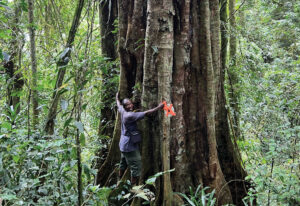
(Phys.org science news website – UK) Extract: The Udzungwa Mountains, part of [Tanzania’s] Eastern Arc Mountain Chain, are home to many wildlife preserves. Members of the team were hiking in the Uluti Village and the Boma la Mzinga Forest Reserves when they came upon a large tree back in 2019 that none of them recognized. Its flowers had thin white petals with tiny yellow bulbs on the tips. Intrigued by their find, they took pictures and collected leaf samples for study back in their lab. They have been able to confirm that the tree is a species that has not been recognized by the scientific community. The team named it Tessmannia princeps. In addition to its massive girth, the tree grows a little taller than others around it in the rainforest, which is why the team gave it the name “princeps”—a Latin word meaning “most eminent.” More recently, team members returned to the site and found approximately 100 of the trees, one of which had fallen due to natural causes. That allowed them to collect wood samples for testing. The results showed that some of the newly discovered trees could be up to 3,000 years old. They are also slow growing, taking up to 15 years to add 1cm of girth. The researchers note that there are many scarce species of plants and animals found only in the Udzungwa Mountains and Udzungwa’s Mngeta Valley. Because of that, the entire area has been designated a national park, which means trees cannot be cut down or harmed. That is good news for Tessmannia pinceps, the team notes, because of its slow-growing nature and low numbers mean it could very well disappear if disturbed by human activities. (21 March 2025)
The blind man coaching a Tanzanian football club
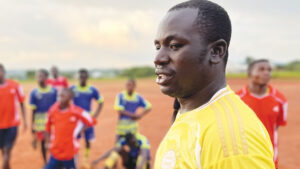
(BBC.com news website video clip – UK) Tanzania will co-host the Africa Cup of Nations in 2027 alongside fellow East African countries Kenya and Uganda. It is hoped that the tournament will inspire a new generation of talent across the region. One football coach in Ruvumu in southern Tanzania is already helping players improve and has established himself as a role model in his community – despite being blind since birth. The BBC’s Alfred Lasteck visits Mfaranyaki City FC to attend one of Priver Ngonyani’s training sessions. Video transcription: Priver Ngonyani may be blind, but he still sees the game. [Ngonyani] “My ears are sharp and my senses are exceptionally strong. This allows me to recognize who is playing well and who is underperforming.” He has coached Mfaranyaki City FC in Tanzania for 10 years. His players believe in his abilities. [Rogatus Mbawala – Team captain] “We don’t use his disability to go against what the coach asks of us. When he gives instructions for the sessions, I act as a supervisor collaborating with my teammates.” [Ngonyani] “When I discipline a player one accepts it because they trust me. This trust has made us a family, both on and off the pitch.” The job is not lucrative but his passion keeps him on the pitch. Born blind, Ngonyani has to deal with societal stigma. [Ngonyani] “People assume I lack the ability to coach football. This makes it extremely difficult for me to secure opportunities and prove my skills with confidence.” It’s estimated there are 290,000 blind people in Tanzania. Ngonyani hopes to change attitudes towards them. [Ngonyani] “When given a chance, we can achieve a lot. I’m capable of helping many teams succeed.” (24 March 2025)


